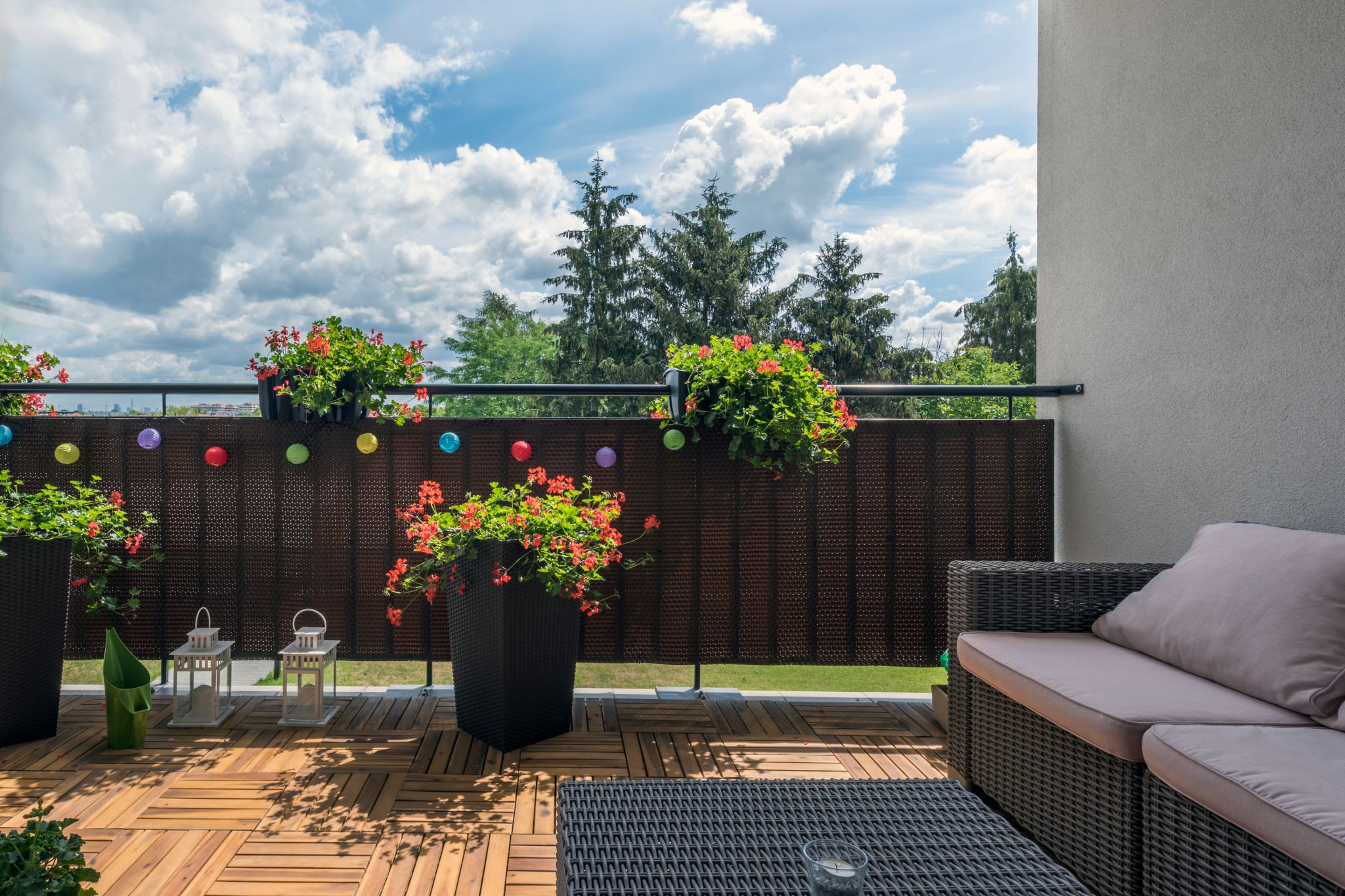Oh, your poor, sad patio. Not a comfy seat to be had, and that cracked concrete . . . well, it probably looked really great when disco was king.
Whether you love to entertain friends or bask in the sun with a cocktail and a novel, here are 10 easy ways to inject new life into your little corner of nature.
Get Creative With These 10 Backyard Patio Ideas
#1 Use Pine Cones to Stop Patio Pests
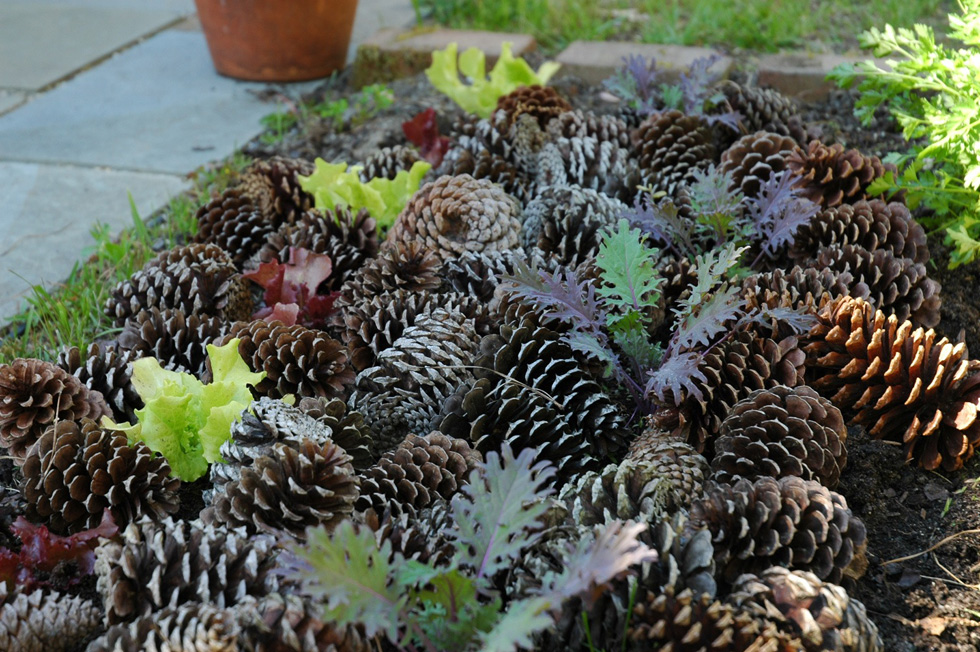
It's hard to enjoy your patio if it's covered in debris scattered by the wind or by critters with a penchant for digging and trampling. Stop critters with the humble pine cone — instead of regular mulch.
Those spiny cones will deter pests and mischievous pets.
And chances are your plants will LOVE them because they acidify the soil. Showstopper plants like azaleas and rhododendrons will burst with color.
Pine cones also decompose slowly, so you won't be constantly re-upping your supply. That will save you time and money; in most parts of the country, you can easily find them for free.
#2 Make a Concrete Patio Pop With Color

Rejuvenate that dilapidated patio with color in a can.
Try painting it a bold, bright color or a fun pattern, like chevron. You can also mimic the appearance of upscale stone patios with just a bit of paint and some stamps.
If you want to let your creative juices flow, try mimicking a carpet or even a game board, such as Twister. At the very least, a new coat of concrete stain will give that tired concrete a fresh look.
Related: How to Paint Concrete
#3 Remove Rust from Outdoor Furniture
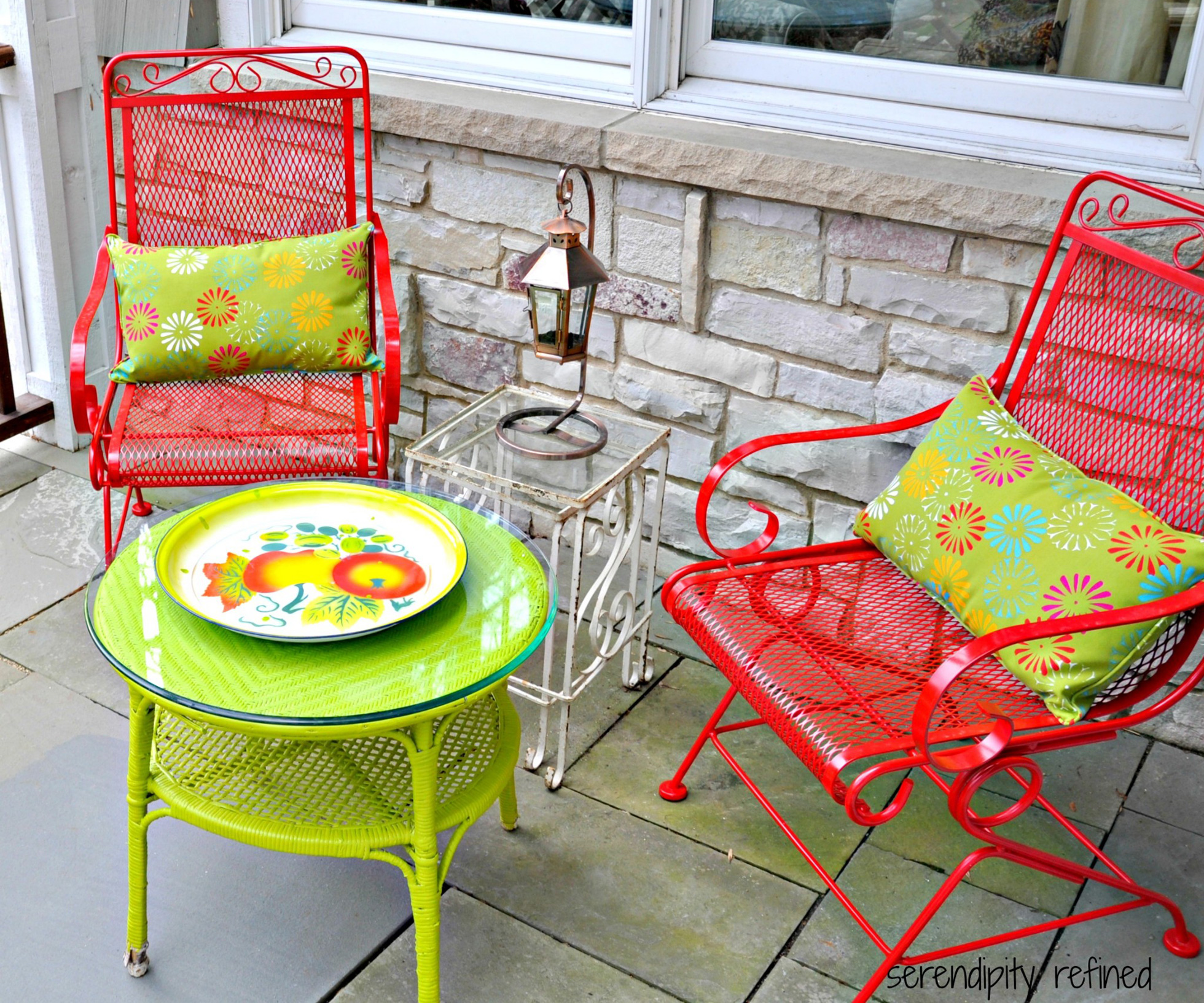
Lounging on your patio, cocktail in hand, requires something to lounge on.
But if that secondhand chaise you bought post-college is covered in rust, you're not going to be relaxing on it in your summer whites anytime soon. But replacing it is expensive — and a waste! Give it a rust-busting makeover, instead.
You have several ways to remove rust. If the damage isn't too extensive, the job can be as simple as scraping off the rust. Use a wire brush, sandpaper, or steel wool — and a bit of elbow grease — to scour it away. For less effort, use a drill with a wire brush attachment.
For more extensive rust issues, you can use an acidic agent like vinegar to help with the removal. Or use a chemical rust converter (such as Rust-Oleum), which actually changes the rust into a different substance. It also protects against future rusting, adding years to your chaise's lifespan.
Paint over the treated spot and that chaise will be right back in its glory days and ready for you in your white shorts.
#4 Design Outdoor Creative Storage Spaces
If a dumpy layer of clutter and scattered pots make your patio look sad, consider adding DIY storage to keep all of your outdoor whatnots neat and tidy.
An easy option is to paint wooden crates (about $10 each) to complement your patio and weatherproof the wood with a sealant. Arrange them to create attractive storage.
#5 Plant Perennials Instead of Annuals
Flowers are a sure (and budget-friendly) way to add pops of color and eye-catching beauty to perk up a down-in-the-dumps patio. When you’re deciding what to plant, the first decision is annuals versus perennials.
Annuals have their pluses. They mature faster, so you’ll see lots of blossoms soon. And they appeal to the fickle among us (you know who you are). You get bored with an English cottage garden one year and want to switch to a Mediterranean look the next.
But in the long run, perennials are a better investment, and they grab just as much attention as annuals. It’s true they’re more of an upfront investment, but the flowers return year after year. Even though some bloom for just a few weeks a year, others bloom more than once, or, like bleeding hearts, are long-term bloomers.
There’s another budget and maintenance benefit: After perennials are established, they don’t need as much water. They’re especially compatible with drought-prone areas (and there’s no shortage of those these days!).
#6 Hang Simple String Lights
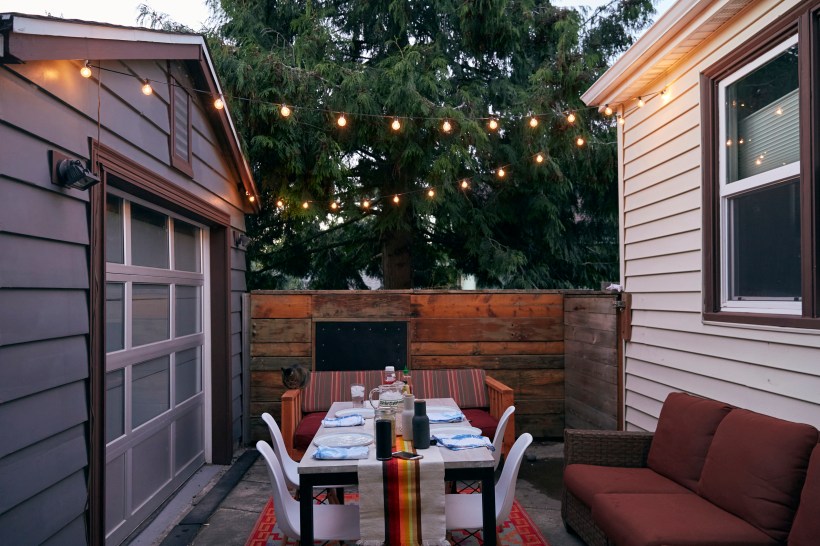
Why limit lights to holidays when you can add string lights to your patio or backyard and bask in the magic for several seasons of the year?
Don’t be afraid to get creative. Sure, you can hang light strings on trees. But what about suspending them above a dining area, maybe in parallel rows? Or illuminating your whole backyard by anchoring the lights to a large tree and the roof of your house? You can even drape them over a privacy fence to liven up a functional backdrop.
When shopping, check whether the bulbs are removable for replacement. Opt for outdoor string lights that are durable and safe to be used outside. That means they should be outdoor rated and designed for all weather conditions.
Solar string lights run on energy from the sun, and if you don’t have an outdoor outlet, they may be what you need. The charging panel will need to be in an area that gets a lot of sun.
#7 Shade Your Space
No matter how much you love being outside, when the sun’s scorching, you’ll want to grab your drink and sunnies and head for the AC. Unless you have shade, that is. A shade option will help you get the most out of your patio and yard.
One solution is the natural route. Planting trees and hedges not only cools off your patio but also adds beauty, a relaxing vibe, and privacy. (Some trees can even be in planters.) The downside: It’ll take a while for new plantings to get established so they offer much protection.
A quicker-growing natural choice is vines that can be trained to climb trellises. Experts say vines that work well are morning glories, hops, sweet peas, clematis, and black-eyed Susan.
While you’re waiting for your new plantings to mature — or instead of them — consider a pop-up gazebo. It’s less expensive than the permanent version and can be easily moved where you need it. If you’re looking for shade for entertaining or sun relief in a smaller area, think about adjustable choices like offset umbrellas. They allow you to direct the shade more than the standalone versions do, but they’re more expensive.
#8 Go Vertical With Your Garden
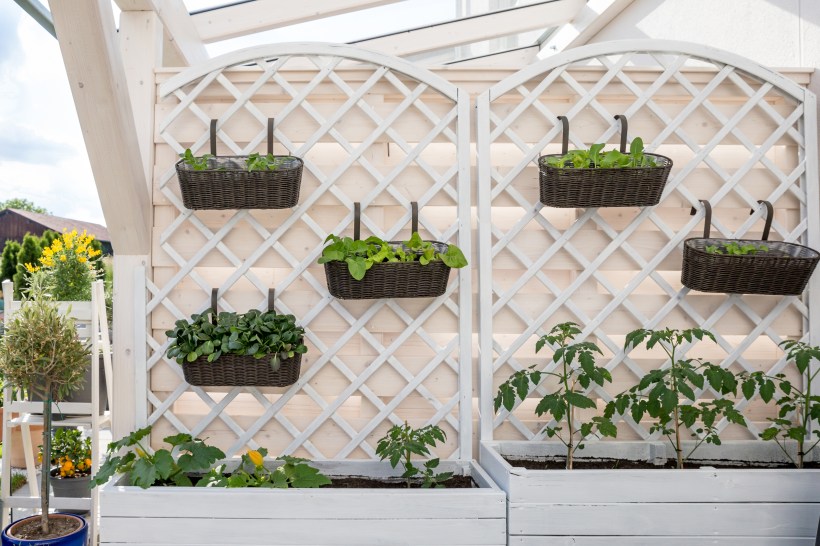
Vertical gardens have a lot to offer. They improve curb and backyard appeal. Because they grow plants upward instead of outward, they’re at eye level and add depth and visual interest to a yard. If you live in an urban area with a small outdoor space, think about how much you can increase growing space by planting upward.
Regardless of where you live, plants raised off the ground are typically healthier and have fewer pests and diseases, including critters digging them up. The plants are easier to reach for maintenance (no more bending over to weed). Finally, you can get an extra layer of privacy — and block the view of your neighbors’ trash cans — by adding plants to a fence or garden wall.
A few tips: You can plant a vertical garden in sun or shade, but choose plants according to where you intend to put them. Plants in a vertical garden tend to dry out quickly, so use potting soil to retain moisture better. Lavender and other woody varieties of plants are hard to train to grow upward, which doesn’t matter if you’re using pots. If you’re training plants to grow upward on a surface, though, consider herbaceous varieties, which have soft, green stems.
You can start simple, like leaning an old ladder against a wall and using the steps as shelves for plants. Or using landscape fabric to create a vertical herb garden.
#9 Mix and Match Seating Instead of Buying a Patio Set
If your outdoor furniture needs a refresh, buying a patio set isn’t the only way to go. You don’t need a whole set if you have a table and a chair or two that look (almost) new, but others may look a little too — uh, lived in. How about that chair leg your dog, Sophie, used as a chew bone? That one has to go.
Or maybe you don’t have condition problems, but you don’t want a cookie-cutter look.
A great option is to mix and match your patio seating pieces for a more personalized, interesting look, according to designers. The trick is to use a material, color, or pattern to tie things together.
Patio furniture is usually made of some combination of metal, wood, wicker, or resin. You can mix pieces but still make them look related if they have at least one material in common. For example, if you have a glass table with metal legs, you could add metal chairs. Wood and fabric-covered chairs can complement a wood table.
Color connects your outside pieces as well as it does your inside furniture. Pick a color or colors and use them on cushions or in painting the chairs themselves, even though the chairs aren’t identical. (Spray paint works especially well on wicker, but use may be restricted in some areas.) You can carry out the colors or patterns from your patio plants or even find cushions or pillows with a pattern that resembles a wicker pattern you’ve used elsewhere on the patio.
#10 Build a Fire Pit on a Budget
Sometimes the best way to distract from a patio that needs some love is by drawing attention to a feature that does nothing but delight. A mini fire pit can serve as an arresting visual focal point while adding more fun and function to your patio.
Creating your own outdoor s'mores-making oasis doesn't have to take much time or money. The cost of a fire pit depends on materials, size, and features, according to Lawn Love. You can spend as little as $200 for a small, simple fire pit that's 36 inches or so, Lawn Love says. The least expensive material is concrete, which you can cost you as little as $150 including installation.
Make sure your patio is constructed with fire-safe materials before attempting this project (sorry, wooden deck lovers) and follow local fire codes.
Time to grab a few marshmallows!
